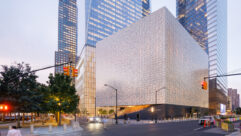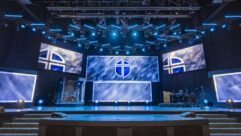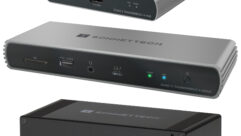A FIRM hold
Jul 1, 1998 12:00 PM,
Paul Allen
People unfamiliar with our industry would probably not consider mountingloudspeakers much of an art form even though it is, and it can beespecially satisfying when properly planned. It is the method of achievingthat satisfaction, knowing that the loudspeakers have been correctlyinstalled, that I want to share.
In ten years of developing loudspeaker mounting systems with manufacturers,sound designers and contractors, I have learned that planning is importantto the quality and profitability of audio installations. What follows is alist of critical factors involved in making and implementing your mountingplans. Keeping them in mind will reduce design and setup time, cut down oncallbacks and increase your application’s service life. Please note that Ibegin with the assumption that you have already selected the properloudspeakers needed to cover the intended area.
Wall mountingRegardless of the type of mount, always make sure that the anchoringfasteners of the mounting system are secured into a structural orreinforcement member, such as a stud, brace or beam. Unless the loudspeakerweighs less than approximately 5 pounds (2.3 kg), you can rule out mountingdirectly to drywall, sheet rock, gypsum or plaster.
Ensure that the mounting hardware not only goes into a rigid member, but isalso in far enough to secure the loudspeaker and mount safely. The deeperyour fastener penetrates a stud or other structural member, the morepull-out force it can withstand. So make certain your fastener is longenough for the job. Considering a wallboard thickness of 3/4 inch (19 mm)plus the mount and applicable hardware, you may need a fastener as much asa full inch (25 mm) longer than previously thought. Also be aware that ifyou hit a stud off-center or use an oversized screw you can split the stud,which will weaken the mounting hardware’s hold.
Block, brick or cement walls can provide either a stronger or weakermounting surface, depending upon the selected fastener and mounting method.Some methods work well to support weight in shear, but cause a pullingforce on parts of the mounting hardware. You must evaluate the forces yourmounting system will impose on the wall material, and select your componenthardware accordingly. Also, retrofits to older walls can be delicate. Besure that the wall materials do not crack or crumble, and that yourfasteners anchor solidly into the wall material. Given properconsideration, these wall materials are excellent for mounting.
Ceiling mountsThere are a wide variety of ceiling structures you might encounter in thefield-so many that another article could be devoted to that subject alone.I do want to point out, however, how important it is to be logical in yourapproach and keep safety firmly in mind.
Always find a solid, anchored member (such as a truss or beam) that cansupport not only its own weight, but also all the weight of the apparatusthat you will attach to it. With a dropped ceiling, find or build astructural attach point above it that will safely divide the load of theloudspeaker. Then anchor the mounting system to that structure. Practicaldesigns include a dropped pole mount or threaded rod running through thedropped ceiling. Even a simple load-rated cable or chain system willsuffice, as long as you adhere to the factor of safety guidelines describedlater in this article.
I recently learned about a ceiling-mounted projector installed in a school.It was suspended below a dropped ceiling and held in place by four threadedrods. Unfortunately, the nuts and washers that held the projector wereundersized. Eventually, they pulled through the mounting holes, and theprojector fell. Fortunately, no one was hurt, but this situationillustrates that even with the correct mounting device, incorrectlyspecified hardware will cause the system to fail.
The loudspeaker enclosureMany loudspeaker manufacturers are integrating pick-up attachment pointsinto their designs. In these products, the enclosure is usually reinforcedfor suspending and/or mounting, and the pick-up points may appear as T-nutsor internal brackets or braces with threaded holes.
If, however, you have specified a loudspeaker without pick-up points, addthem yourself. Contact the product’s manufacturer before attempting to adda mounting point. Many loudspeaker cabinets are not designed to supporttheir own weight. Loudspeaker companies will usually welcome your callbecause it will clue them in on new ways that their products are being used.
Factor of safetyAlways evaluate your installation method in light of its weakest link, andinclude a proper factor of safety. Here there are three key areas forconcern:
* The mounting point on the loudspeaker system
* The mounting point on the wall, ceiling or deck
* The physical mounting equipment and hardware
Because the mounting area and the loudspeaker enclosure’s construction areusually decided prior to installation, obtain the best mounting materialsdesigned to support more than the weight of both the loudspeaker and itsmounting hardware by a healthy multiple. In static indoor environments, Ihave heard experts quote various rules of thumb-from three times theworking load all the way up to ten. Because it costs only a little more tobuild in a safety factor of ten times the working load than it does tobuild in three or five, why not make it ten? The formula is simple enough.To estimate a safe working load, take the combined weight of theloudspeakers and all mounting system components and multiply that number bythe factor of safety. For example, consider mounting or suspending a 50pound (22.5 kg) loudspeaker, and the mounting equipment weighs anadditional 10 pounds (4.5 kg). With a factor of safety of ten, the formula(50 + 10) x 10 yields a safe working load of 600 pounds (270 kg). Becausethe working load of cable and chain is rated by its manufacturer, you canselect the proper gauge and type for the job easily. Similar ratings areavailable from the manufacturers of crimping components and wall andceiling mounting equipment.
Dynamic conditions, including wind, rain, ice and snow, may affect thefactor of safety you use, in which case multiplying by ten may not beenough. For a loudspeaker application in a school gymnasium, the impact ofa basketball might exceed your factor of safety. A student may even climbon the loudspeaker or mount. And what about other unpredictable events,such as seismic activity? Consulting a local registered structural engineerto review your application does not cost an excessive amount, and it canreally help guide you in these areas. Whenever lives are involved, expertengineering advice is never too expensive.
Mounting systemsHere are some typical mounting methods currently in use:
* Built-in shelving: Permanent loudspeaker installations, such as thosefound in churches, commonly employ built-in landings or shelves. They canblend in nicely with the interior design and deliver adequate acoustics ifinstalled at the right height.
* Brackets: U-shaped brackets (see Figure 2) can be used horizontally orvertically, are easy to install and provide one axis of rotation foraiming. They can help with placing a loudspeaker high up on a wall, ceilingor balcony structure where it would be more out of view. Otherinstallations include mounting to trusses, beams and even pole mounts.Loudspeaker manufacturers frequently make brackets for these situations.More sizes and types of brackets can be purchased from specialtymanufacturers, and some prefer to design their own brackets rather thansource them through local fabricators.
* Tilt and swivel mounts: These flexible products, offered by severalmanufacturers, are designed to allow the contractor to aim a loudspeaker inany direction. They cost more than simple brackets, but they compensatewith their greater flexibility in tuning an audio environment. Thesedesigns typically have a smaller mounting footprint than a U- bracket, soadditional attention to structural integrity is necessary when selectingthe method you use to attach them to the mounting surface.
* Suspension systems: Load-rated cable and chain suspension systems areacceptable methods of installation. Between the two, however, many preferthe cosmetics of cable. Cable ends are usually attached using a crimp (orclamp) method, and great care must be given to the integrity and capacityof the preparation of these ends. If chain is preferred, use a welded chainthat is load rated by the manufacturer. The tensile strength of unweldedchain is far inferior to that of the welded chain, and if the cable has notbeen properly rated for the application, there is a huge liability for theinstaller.
Dropped piping and threaded rod are common ways to suspendloudspeakers-even full arrays-but they frequently require adding asubstantial framework to the ceiling structure. Such designs as theseincrease installation time and materials cost but may be the only reliableway for you to deliver sound to the desired area.
* Back-up safety system: Murphy’s Law applies to loudspeaker installations.Sooner or later, something can go wrong, no matter how much planning goesinto the installation. Back-up safety systems are critical to theinstallation, and no installation is finished until one is implemented. Askyourself if a safety cable or bracket can be installed that couldcompletely bypass the mounting system. This, of course, would meanattaching your back-up system directly to the loudspeaker and mountingsurface in locations different from where the mounting system is attachedand where the loudspeaker is anchored. Do not overlook this step.
EnvironmentThis is a fun and challenging area because we are forced to think aboutpowerful yet barely perceptible forces that affect your installation. Hereare some typical environmental considerations to work through beforesettling on an installation design:
* Temperature: Most mounting methods are not directly affected bytemperature. Problems do arise, however, when temperatures swing back andforth between extremes of cold and hot. Such temperature excursions expandand contract materials, eventually causing component fatigue (especially inplastics) and/or loosening. Also, pay special attention to any place wherewater can collect and freeze because hardware and mounting systems can bevulnerable to damage from icing.
* Corrosion: The most common corrosive agent is simply air and moisture.Regular exposure to humidity in an audio environment can be a threat overtime. If your materials are made from metals, ensure the materials areproperly coated, painted or plated to resist corrosion. Causticenvironments compound the moisture problem and hasten corrosion further.Refinery and automobile pollution, salt atmosphere and other causticenvironments will adversely affect your installation. Select the propermaterials for the job.
* Vibration: Loudspeakers vibrate. Buildings vibrate, too, because of airconditioners and heating systems and the constant flux of changing internaland external atmospheric pressure. All of these different vibration sourcesand frequencies will put an installation to the test. Hardware can looseninvisibly, so precautions must be taken to make certain that anyloudspeaker, once installed, will remain permanently in place. Use lockingor high-friction washers and nuts on all screws and bolts. In addition,screw and bolt threads can be treated with any of several differentcommercially available applications, such as fast-drying friction liquids,and you can specify nylon-packed nuts or nuts that are deformed to increasefriction.
* Dissimilar materials: Always attempt to use components made of similarmetals when building or installing a mounting system. When dissimilarmetals are used, you run the risk of the damaging effects of electrolysis,especially in humid or corrosive environments. This decaying process-alsoknown as galvanic corrosion-will slowly eat away the host material ofmetallic components, which is not a pretty thought when you consider thesecomponents may be placed above your head.
Some dissimilar materials corrode faster than others, so if you must usedissimilar materials together, select the most compatible materials for along application life. From an electrical properties point of view, thereare more positively charged materials (like magnesium) and more negativelycharged materials (like platinum). The greater the difference in electricalproperties among the materials, the more severe the galvanic corrosion, andthe faster the host materials decay. Therefore, use materials as close toeach other electrically as possible (such as zinc and aluminum or aluminumand steel) and use barrier coatings such as plating, anodizing or painting.For help in making material selections, galvanic tables are available fromlocal metal suppliers and manufacturers and the local library.
* Ultraviolet light: I have not heard of any UV-related safety issuesconcerning loudspeaker mounting systems, but there are cosmetic reasons totake it into account. Plastics have become more sophisticated over the lasttwo decades. Today, UV inhibitors are frequently included in the basicchemical composition of many commercial plastics. Even with this addedprotection, however, UV still advances the aging of plastics and eventuallycauses a form of dry rot. Colors fade, and black can actually discolor to achalky white. The same effect happens to rubber components, so be aware ofmaterials subjected over long periods of time to the hot sun or other UVsources such as quartz, mercury and fluorescent lighting.
* Reflection/gloss: Several years ago, I sat through a two-hour movie wherea small, shiny reflection glared at me from behind the movie screen.Although I cannot tell you a thing about that movie today, I still rememberevery aspect of that annoying reflection. If you want your installation toattract as little attention as possible, avoid reflective materials andsurfaces. In most applications, especially in environments such as theatersor stage, specify both the color and gloss of your loudspeaker and mountingapparatus. Several different hardware finishes are available. Black oxideoffers a dull, flat-black finish but will not hold up well in humid orcorrosive environments. Black zinc, by contrast, offers terrific corrosionprotection but is somewhat more reflective. Proper placement can compensatefor this, so we usually opt for zinc for greater longevity. Brackets,cables and other mounting materials can be painted or plated in the colorand gloss you desire.
* Security: Many educational facilities require some sort of securitymeasure because loudspeakers are enticing to students. In suchinstallations, you should carefully evaluate the mounting system formasking and determine what hardware would most discourage theft. There are,for instance, a wide variety of rivet and screw types that require specialtools to be installed and removed. (This is a good time to illustrate wherefactors of safety are important. If someone is attempting to remove aloudspeaker, he may apply his entire body weight to the loudspeaker andmounting system. Does your factor of safety take this into consideration?)
* Sound isolation: Do not underestimate the resonance factor of walls andceilings, especially hollow ones. Back in my grade school days, before Ihad an amplifier, I would lean my electric guitar against a wall to getenough volume to hear myself. That was an advantage for me then, butchances are it will be a negative at your job site. To avoid this problem,look for ways to isolate the loudspeaker from the mounting surface. Insuspending the loudspeaker from cable, however, structural isolation isalmost a non-issue. If mounting directly to a wall or ceiling, you canreduce much of the sound transmission by installing a sound barrier betweenthe mount and the mounting surface. Commercially available rubber and foammaterials can be inexpensively and quickly applied and yield terrificresults. There are also fasteners that actually provide the sound isolationbetween the mount and the mounting surface. Similar materials and fastenersare available to deal with isolation between the loudspeaker and the mount.In the end, quality needs and budget will dictate the approach theseproblems.
In every job, there often are dozens of variations of installationspossible that will get the job done. Your advanced planning sessions formounting loudspeakers should consider (in equal doses) quality, availablematerials and methods, safety, environment (long term), installation timeand budget. If you are completely satisfiedwith the final installation,chances are your customer will be as well, and you will get the only reallyacceptable call back-the next job.










